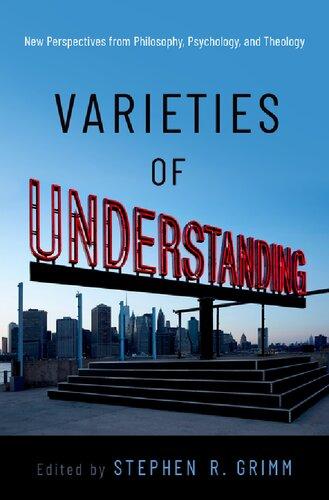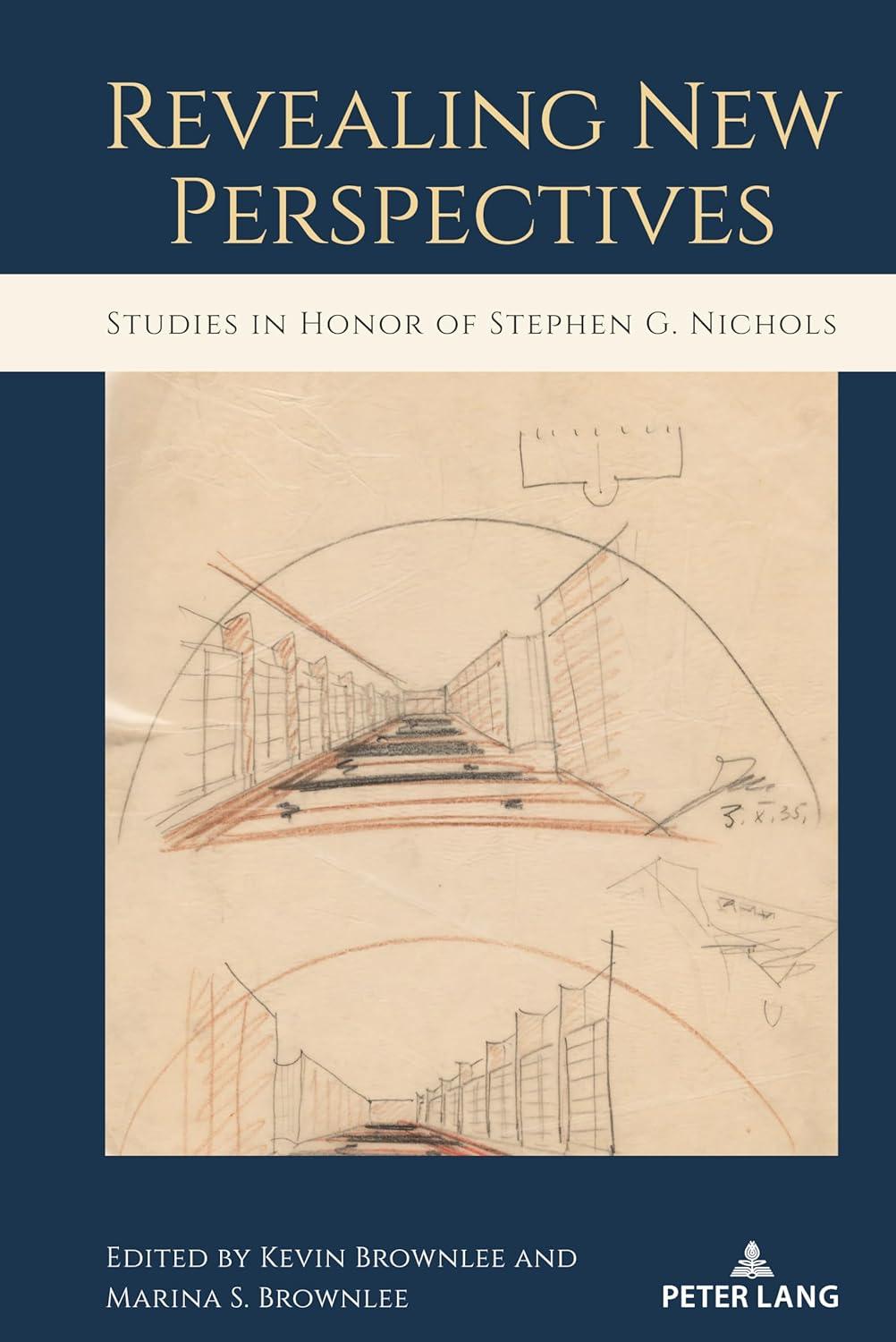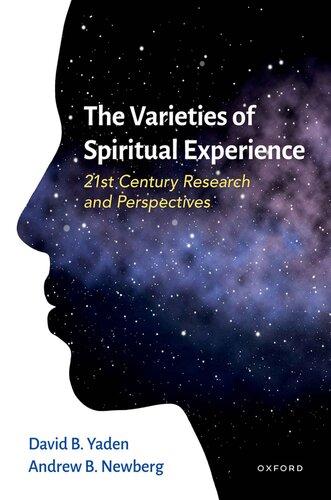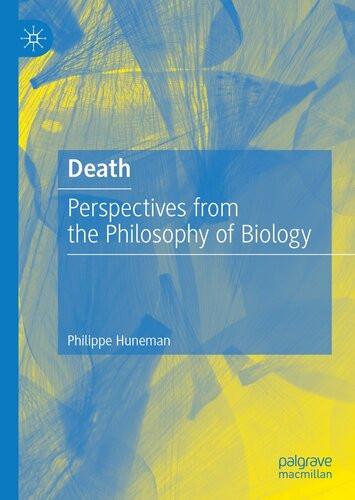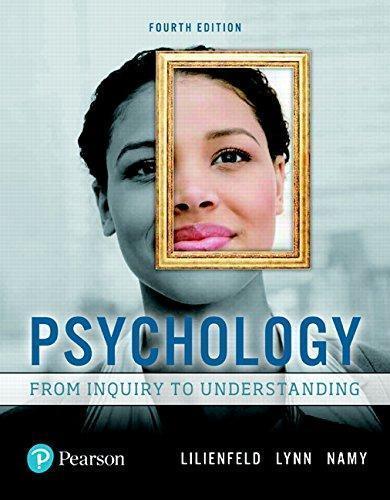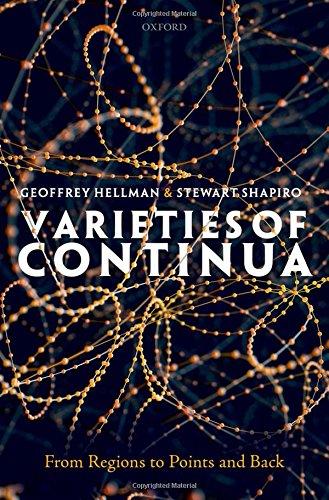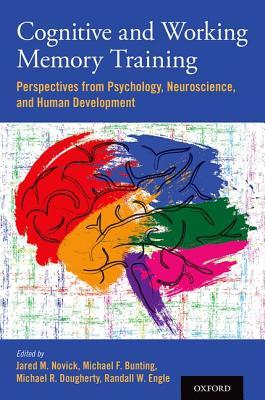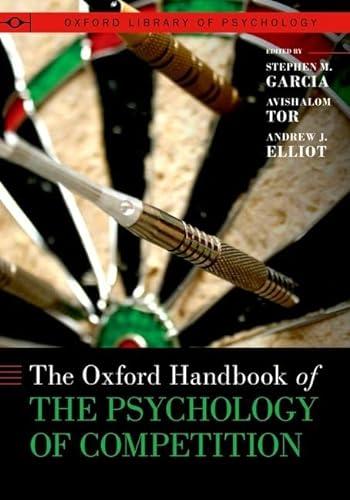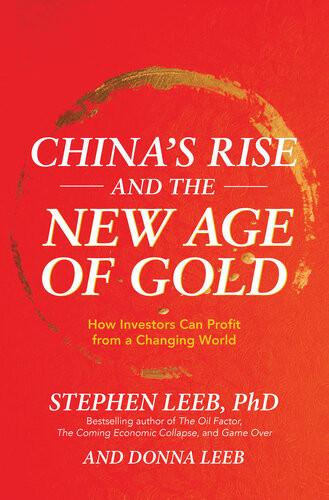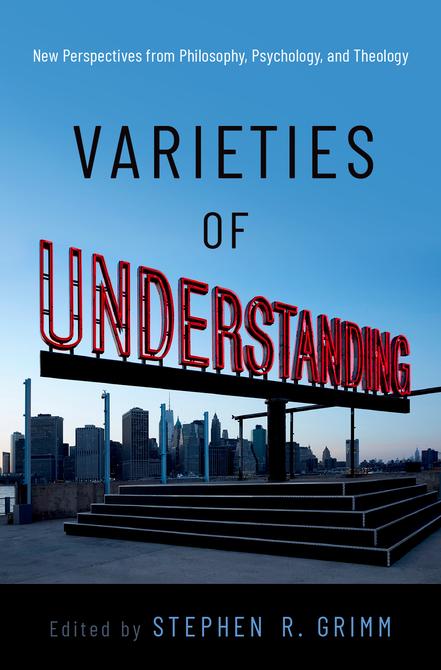Varieties of Understanding
New Perspectives from Philosophy, Psychology, and Theology
Edited by STEPHEN R. GRIMM
Oxford University Press is a department of the University of Oxford. It furthers the University’s objective of excellence in research, scholarship, and education by publishing worldwide. Oxford is a registered trade mark of Oxford University Press in the UK and certain other countries.
Published in the United States of America by Oxford University Press 198 Madison Avenue, New York, NY 10016, United States of America.
© Oxford University Press 2019
All rights reserved. No part of this publication may be reproduced, stored in a retrieval system, or transmitted, in any form or by any means, without the prior permission in writing of Oxford University Press, or as expressly permitted by law, by license, or under terms agreed with the appropriate reproduction rights organization. Inquiries concerning reproduction outside the scope of the above should be sent to the Rights Department, Oxford University Press, at the address above.
You must not circulate this work in any other form and you must impose this same condition on any acquirer.
CIP data is on file at the Library of Congress ISBN 978–0–19–086097–4
1 3 5 7 9 8 6 4 2
Printed by Integrated Books International, United States of America
List of Contributors vii
1. Varieties of Understanding 1 Stephen R. Grimm
I. PHILOSOPHY OF UNDERSTANDING
2. Perspectives and Frames in Pursuit of Ultimate Understanding 17 Elisabeth Camp
3. The Epistemologies of the Humanities and the Sciences 47 Richard Foley
4. On Literary Understanding 67 Jennifer Gosetti-Ferencei
5. Recasting the “Scientism” Debate 93 Anthony Gottlieb
6. Firsthand Knowledge and Understanding
Ernest Sosa
7. Toward a Theory of Understanding
Linda Zagzebski
II. PSYCHOLOGY OF UNDERSTANDING
8. Technology as Teacher: How Children Learn from Social Robots 139 Kimberly A. Brink and Henry M. Wellman
9. Understanding Others to Learn and Help Others Learn: Inferences, Evaluation, and Communication in Early Childhood 167 Hyowon Gweon
10. How Do Partial Understandings Work?
Frank Keil
11. Mechanistic versus Functional Understanding
Tania Lombrozo and Daniel Wilkenfeld
12. Are Humans Intuitive Philosophers?
Steven Sloman, Jeffrey C. Zemla, David Lagnado, Christos Bechlivanidis, and Babak Hemmatian
III. THEOLOGY OF UNDERSTANDING
13. Religious Understanding and Cultured Practices
Terrence W. Tilley
Contributors
Christos Bechlivanidis, University College London
Kimberly A. Brink, University of Michigan
Elisabeth Camp, Rutgers University
Richard Foley, New York University
Jennifer Gosetti-Ferencei, Johns Hopkins University
Anthony Gottlieb, Oxford University
Stephen R. Grimm, Fordham University
Hyowon Gweon, Stanford University
Babak Hemmatian, Brown University
Frank Keil, Yale University
David Lagnado, University College London
Tania Lombrozo, Princeton University
Steven Sloman, Brown University
Ernest Sosa, Rutgers University
Terrence W. Tilley, Fordham University
Henry M. Wellman, University of Michigan
Daniel Wilkenfeld, University of Pittsburgh
Linda Zagzebski, University of Oklahoma
Jeffrey C. Zemla, Brown University
Varieties of Understanding
Stephen R. Grimm
Imagine that you’re trying to understand why your neighbor is acting in a certain way—why he’s being less talkative than usual, perhaps. Does understanding your neighbor require something significantly different, from an epistemic point of view, than understanding an event in the natural world, such as a change in the tides or an eclipse? More generally, does understanding people differ in important ways from understanding physical events or phenomena?
According to a long historical tradition, the answer to both of these questions is yes. Understanding comes in different varieties, it is said, and understanding people has a different epistemic profile than understanding the natural world—it calls on different cognitive resources, for instance, and brings to bear distinctive normative considerations. Thus philosophers such as Wilhelm Dilthey and R. G. Collingwood have argued that in order to understand people we need to appreciate, or in some way sympathetically reconstruct, the reasons that led a person to act in a certain way.1 By comparison, when it comes to understanding natural events, like earthquakes or eclipses, no appreciation of reasons or act of sympathetic reconstruction is needed—mainly because there are no reasons on the scene to even be appreciated, and no perspectives to be sympathetically pieced together. Instead, to understand these events, we simply need to identify the natural laws that gave rise to them, or perhaps to identify their place within the intricate causal networks that make up the world.
For convenience, let us call the tradition associated with Dilthey and Collingwood the “humanistic tradition.”2 This tradition says that
1 See, for example, Dilthey (1996) and Collingwood (1946).
2 It has also been called the “verstehen tradition”; see, e.g., Martin and McIntyre (1994) and Stueber (2012). Verstehen is the German word for understanding, and the idea here (roughly) is that while things like eclipses might be explained, only human beings, properly speaking, can be understood. See Grimm (2016) for a sympathetic but critical discussion of this distinction.
understanding comes in different varieties, and in particular that there is a gulf between understanding human-related phenomena and natural phenomena.3 Opposed to this view is what we might call the naturalistic or scientistic tradition. It says, roughly, that understanding comes in only one variety.4 While it might be true that we try to appreciate the reasons that are leading our neighbor to be less talkative, or that we might try—in some sense—to imaginatively enter into his or her shoes, the naturalistic tradition claims that these sorts of efforts are at best stepping stones along the way. When all goes well, they will simply lead to the same impartial framework of laws, causes, and mechanisms that we find in the natural sciences.
In order to evaluate the dispute between the humanistic tradition and the naturalistic tradition, it will help first to clarify two different questions, which I will take up in the following section:
1. What would it take for understanding to count as having different varieties?
2. Even if we allow that understanding comes in different kinds or varieties, what is it that make them all cases of understanding i.e., different varieties of the same thing?
In the course of addressing these questions, I will touch on several essays in the collection, although I will not try to offer detailed summaries. This introduction is rather meant to set the stage for later chapters in the volume, without attempting to be comprehensive.
1. Different Varieties
Beginning with the first question, about what it would take for understanding to count as having different varieties, we can start with the simple observation that our understanding of the world is wide ranging. On what we might
3 Note that I am not suggesting with this distinction that human beings are non-natural. It would therefore perhaps be clearer to say that the distinction is between human beings—or more advanced agents generally—and the rest of the natural world. But the traditional debate has generally been conducted in the former terms (human events vs. natural phenomenon), and I will continue that tradition here.
4 See, for example, Peter Atkins, who claims that “Science is the only path to understanding” (Atkins 2006: 124). Of course, there might be lively disagreement about what that one variety is (whether basically nomic, or causal, etc.).
call the larger scale, there are those who understand how fermentation takes place, why certain people are vulnerable to type 2 diabetes, why sea levels are rising, and why graduate students are increasingly reporting cases of depression and anxiety. On the smaller, everyday scale, we also understand countless little events. Walking downstairs in the morning, I understand why my dog is looking at me expectantly (because he wants his breakfast), why my coffee spilled (because the table wobbled), and why my morning paper was delayed (because of the ice storm). Noting the large number of things we understand, we can therefore ask: When would differences between these instances of understanding count as deep enough to mark distinct kinds or varieties of understanding?5
Consider by comparison how this question might look if asked of knowledge, rather than understanding. What would it take for differences among instances of knowledge to count as deep enough to belong to different kinds or varieties? Suppose I visually scan my kitchen table before dinner, taking in its various forks, plates, and cups. I will thereby have acquired several new instances of knowledge—that there is a fork here, a plate here, and cup over there—but it nonetheless seems mistaken that I will have thus acquired several new varieties of knowledge: “fork knowledge,” for instance, as opposed to “plate knowledge” or “cup knowledge.” It seems more apt instead to say I have acquired several new instances of the same variety of knowledge: roughly, perceptual knowledge.
This would, moreover, accord with traditional categories within epistemology, where distinct bodies of literature are dedicated to topics like perceptual knowledge, as opposed to memorial knowledge, as opposed to a priori knowledge, and so on.6 These all presumably count as varieties of knowledge because they share some common property. But the way in which this common property is attained or acquired seems different enough that these instances merit their own special category.
For the sake of argument, suppose these all count as instances of knowledge because they share the common property of reliably getting things right.7 “Reliably getting things right” would then be the genus encompassing
5 For more on the notion of a “deep difference” with respect to epistemic categories, see Grimm (2017).
6 These distinctions are then usually replicated in epistemology textbooks or anthologies. See, for instance, the distinct chapters in Audi (2011), Bernecker and Dretske (2000), and O’Brien (2006).
7 For more in defense of this claim, see Grimm and Ahlstrom-Vij (2013). According to Kremer (2016), this also seems to have been Gilbert Ryle’s view.
all instances of knowledge, and there would be different varieties or species of “reliably getting things right” if the various ways of getting things right were distinctive enough. For instance, using the faculty of memory to get things right seems distinctive enough that it gives rise to its own variety of knowledge—memorial knowledge. And similarly for perception, a priori knowledge, and so on. By contrast, using perception to reliably distinguish plates from cups from forks presumably does not count as distinctive enough. In short, it seems that when the cognitive resources or powers of the mind in virtue of which we get things right are different enough, we have distinct varieties of knowledge.8
We might also venture a little more, for arguably the reason why distinctive cognitive resources or powers come into play is because the objects known in these areas are themselves importantly different, and hence require different cognitive resources or powers to track them. In the case of past objects or events, a power of the mind like memory; in the case of present nearby objects, a power of the mind like perception; in the case of necessary truths, a power of the mind like rational insight, and so on. Thinking this way would accord with the ancient idea, going back at least to Plato, that deep differences in the object of cognition require (or even give rise to) deep differences in cognitive processes themselves.
Drawing the discussion back to understanding, we can therefore suggest that different varieties of understanding arise, in a way parallel to different varieties of knowledge, if the differences in objects of understanding are pronounced enough that they require different cognitive resources or powers of the mind in order to be grasped. Or if you would prefer to skip the appeal to the objects grasped, we might simply say that varieties of understanding arise when they draw on importantly or markedly different cognitive resources or powers of the mind.
The humanistic tradition holds that this is not just an abstract possibility. Instead, it claims that the cognitive resources or powers of the mind required to understand human beings are different enough that they give rise to a distinctive sort of understanding, with a distinctive epistemic profile. To be compelling, this hypothesis would need to be supported by results from psychology that point to deep differences in cognitive resources when it comes
8 For more on the “powers of the mind” idea, see Grimm (2019). It is worth noting, too, that many powers of the mind blend in with each other—thus perception will often be informed by memory, and so on. But I hope the general point claimed here is clear enough.
to understanding human beings.9 I do not believe any of the psychology papers in this volume make such a case, and I am not sure how any of the authors individually would take sides in the debate between the humanistic tradition and the naturalistic tradition, but they nevertheless help to shed light on these questions by addressing “nearby” or related questions of great importance. I will now turn to these.
2. Psychology
I begin with the framework articulated in Lombrozo and Wilkenfeld’s chapter. They distinguish a mechanistic stance (or mode of construal) from a functional stance (or mode of construal). According to the former, we try to understand things in terms of their component parts, or proximal causes. For instance, we try to understand why the alarm clock is beeping in terms of its internal circuity—the various bits and pieces of the alarm clock that make it capable of emitting such a noise. According to the latter, we appeal to purposes or goals. For instance, we try to understand why the alarm clock is beeping by looking for the purpose of the beeps—most likely, the purpose of waking up the clock’s owner.
Despite these different stances or modes of construal, Lombrozo and Wilkenfeld nonetheless argue that the objects of understanding in both of these cases are the same—namely, dependence relations. 10 When we take a mechanistic stance, we try to identify how the phenomenon depends upon its proximal physical causes—what it is about the alarm clock’s internal circuitry, for example, that gives rise to the beeping. By contrast, when we take a functional stance, we try to identify how the beeping depends upon the psychological goals or purposes of the agents on the scene—for instance, the goals that led the clock’s owner to set the alarm at this time.
9 Work on mirror neurons might be thought to suggest such a case, but it is not clear whether these are essential to understanding other people, or just one pathway among others. For discussion see Stueber (2018).
10 For more on dependence relations, see Kim (1994), Grimm (2016b), etc. On this view, dependence relations would be the genus within which things like causal relations might be a species (e.g., mereological relations, in which properties of the whole depend on properties of the parts, might be another type of dependence relation). Note the similarity between this approach and Linda Zagzebski’s view in this volume. According to Zagzebski, understanding always takes structure as its object. If one thinks structures are necessarily things that encode dependence relations, then the two views are basically identical. From her examples, it is not clear that Zagzebski would subscribe to this view of structure (many maps, for example, do not obviously encode dependence relations—and maps are one of her key cases). But if she did, there would be great overlap here.
This gives us a picture on which the alarm clock’s beeping depends on two sorts of things: on the one hand, the internal circuitry, etc.; on the other hand, the goals and purposes of the person who set the clock. Depending on our interests—or as Lombrozo and Wilkenfeld put it, our inferential goals—we might then focus on one set of dependence relations rather than another. Alternatively, we might take one stance toward the clock rather than another.
According to Lombrozo and Wilkenfeld, because there are two sorts of dependence relations on which we might focus, this picture supports what they call the “weak differentiation thesis,” according to which these stances differ in terms of the understanding they afford because they differ in terms of their objects. As they note, however, the weak differentiation thesis counts as “weak” because the objects at issue—the dependence relations at issue—seem to be quite similar. Or, perhaps better, even though at one level the objects look rather different—physical dependence relations on the one hand vs. psychological dependence relations on the other—it is not obvious that these differences amount to deep differences. After all, on the face of it the objects of perception seem rather different—forks are not plates, after all—but these differences do not seem deep enough to give rise to different varieties of knowledge. In short, from an epistemological point of view, the difference in dependence relations picked out by these different modes of construal might not be significant enough to require distinctive cognitive resources, and hence might not count as different enough to give rise to distinctive varieties of understanding.
They then take up the question of whether there might be deeper differences at play in these cases—in other words, whether there might be evidence for what they call the “strong differentiation thesis,” according to which the epistemic profile of understanding in these cases is deeply different, because of the sorts of cognitive resources involved, or the distinctive objects at issue, or both. Although their arguments on this score are exploratory, they suggest that the normative-evaluative aspect of the intentional stance might yield a different variety of understanding. For instance, when I learn that someone’s behavior is due to certain beliefs and desires, I might then go on to criticize the behavior as a flawed expression of those beliefs and desires. Or I might turn to criticize the beliefs and desires themselves—as inapt, or unfounded, or poorly supported. Proper understanding in these cases might therefore require a sense of what the person should have done, or could have done better. But none of this seems relevant to understanding dependencies in the natural world. I do not critique an eclipse as poorly supported or unjustified.
So, tentatively, the normative dimension of understanding people might require distinctive cognitive resources, of the sort suggested by the humanistic tradition.
In addition to this question about possible varieties of understanding, Lombrozo and Wilkenfeld raise a number of other questions that are partly taken up by other psychologists in the volume:
3. Do people prefer one of these modes of construal to the other, perhaps because they take it to be richer or deeper or more informative than the other?
4. Are we better at acquiring some of these forms of understanding than others?
On both questions, the evidence from Sloman et al. and from Keil paints an interesting picture. Although they do not explicitly contrast mechanistic and functional stances along the lines of Lombrozo and Wilkenfeld, they nonetheless find a preference for mechanism-focused explanations in a variety of areas. Sloman et al., for instance, find that people will prefer more complex explanations to simpler ones, so long as more complex explanation offers information about mechanisms. This is surprising, Sloman et al. suggest, because according to philosophical lore, going back at least to Ockham, simpler explanations are to be preferred to more complex explanations. But things are not so straightforward, Sloman et al. provocatively argue, and our various preferences for things like simplicity, mechanistic information, coherence, etc. plausibly interact to form “a horribly complex system that doesn’t lend itself to simple explanations.”
Keil too explores the various ways in which people—especially young children—show a preference for mechanistic information. If asked why a car is “the right one to buy,” for instance, children will be unimpressed by the answer that it has a very pretty color, or that it makes a cool sound. Instead, if you say things like, the car “is the best because the motor uses high-quality wire that makes it run very smoothly. When you drive, you can speed up and stop quickly,” then children will be more satisfied. This example does not turn on the contrast between the mechanistic stance and the intentional stance, as described by Lombrozo and Wilkenfeld. But it does suggest a strong desire for mechanistic information—perhaps above all other types of information.
Keil also discusses a surprising corollary of this finding. Despite our longing for mechanistic information, human beings are remarkably bad
at storing and retaining this information, or even properly identifying mechanisms in the first place. With respect to the former point, Keil points to studies showing that our knowledge of mechanisms—say, the knowledge we might acquire in a biology class, of how the Krebs cycle works—declines “massively and monotonically over time.” With respect to the latter, a striking example involving bicycles (see Keil, this volume; and Lawson [2006]) suggests that we are not even good at distinguishing possible from impossible mechanisms when we see them, indicating that our ability to recognize mechanisms is weaker than we might suspect.
Gweon, in her essay, and Brink and Wellman, in theirs, also note that a large part of our understanding of the world is secondhand: we learn about the world from others. But clearly some people are better sources of information than others—more exactly, they are more informative than others, and hence are better teachers. How then do we discriminate the good sources from the bad?
According to Gweon, the better sources of information are the ones that give us just the right amount of information: not too much, not too little. So, if a toy has three distinct functions, and a teacher only reveals one to a child, the child will judge this person to be a poor teacher. Or again, if a toy had a hundred buttons that all perform the same function, and the teacher laboriously presses all hundred buttons, the child will judge this person to be a poor teacher. (“I get it,” would be the child’s natural thought, after a dozen or so buttons with identical functions had been pressed.)
Gweon also persuasively shows that we evaluate the quality of teaching based on assumptions about the teacher’s goals, beliefs, and desires. So, for instance, we naturally take it that a teacher’s goal will be to show us all of the important functions of a given device: not to leave any important ones out. At the same time, they do not need to “over-show”—that is, provide redundant information, once it is clear that it has already sunk in. We therefore naturally seem to reason along the following lines: given the teacher’s goals + her beliefs about the subject she wants to communicate + her beliefs about the state of the students’ information, she is / is not achieving these goals well. In short, as Gweon puts it, our understanding of others thus helps us to discriminate the good teachers from the bad. Hence, our understanding of others helps us to better understand the world around us, because it allows us to identify the good teachers around us—the informative ones who tell us what it is important to know, and who leave out the inconsequential or unimportant stuff.
Brink and Wellman further explore the way in which we evaluate robots as potential teachers, and hence as potential guides for understanding the world. What they have found is that young children (up to around the age of seven) prefer information from robots with more human-like qualities, especially those which are able to respond contingently to children’s questions; indeed, not only do they prefer this information, but they seem to retain it better, thus learning more from such robots. As we age, however, the preference for receiving information from human-like robots fades; past the age of seven or eight, we do not seem to learn more, or retain information better, from human-like robots than from non-humanoid robots. Perhaps most interestingly, there is also a point at which robots can appear “too” human, especially to older children and adults, so that they seem creepy or unnerving. This point has been dubbed the “uncanny valley,” and Brink and Wellman surmise that robots reaching this point will be less effective as teachers, for adults, than robots without humanoid traits.
3. Firsthand Understanding
In relation to the articles by Gweon and by Brink and Wellman, I have been discussing our “secondhand” understanding of the world, as when we trust teachers to tell us how various things are related, or depend upon one another.
According to Ernest Sosa’s essay, however, in some domains it is important to understand or know in a “firsthand” way, without deferring to others. Key among these are the domains of morality, aesthetics, and philosophy itself. With respect to morality, for example, to take a position on some issue simply based on the say-so of others is to “neglect one’s rational nature” and to “yield[] the core of [our] humanity” (Sosa, this volume).
But what would firsthand understanding in the case of morality, for instance, actually amount to? In normal empirical cases firsthand understanding or knowledge usually amounts to taking a look—to seeing things for oneself. What might the corollary be in the case of morality?
For Sosa, this seems to require appreciating the grounds or reasons for a certain judgment. Suppose you’re trying to make up your mind about capital punishment, and a trusted advisor tells you that it is morally wrong. You then believe accordingly. According to Sosa, there is something lacking in your attitude until you can appreciate the reasons or grounds for the belief. You would be yielding your autonomy if you were simply to defer.
More concretely, suppose it turns out that capital punishment is wrong because it compromises human dignity. A firsthand understanding of the claim would therefore involve seeing or grasping the way in which this compromise occurs, or perhaps what it is about capital punishment that triggers the compromise. It would also involve, presumably, seeing or grasping in an immediate, non-inferential way that it is wrong to compromise human dignity; for that matter, it would seem to require seeing or grasping in an immediate way that human beings have a special dignity to begin with. And none of this seeing or grasping can be acquired, it seems, by sheer deference. Seeing or grasping is the sort of thing that one needs to do for oneself, if it is to happen at all.
What is less clear about Sosa’s claim is why deferring—at least, to begin with on matters related to morality or aesthetics should be improper, or at odds with our rational nature. Let us grant along with Sosa (and Aristotle, and others) that we naturally seek “the why” of things—presumably, the reason or grounds of things. Why can we not defer or trust, and then seek the why? Perhaps the answer is that this sort of deference or trust might lead us down the wrong path—so we might be seeking whys (reasons, grounds) where there are no whys to be found. This is a fair concern, but what exactly is the epistemic alternative—a life lived without deference or trust, or with deep suspicion of others? As Sosa notes, this in fact has been the attitude of many philosophers, including Descartes and Locke, for whom a secondhand belief was “often dismissed as second rate or even worthless” (Sosa, this volume). But Sosa rightly distances himself from that tradition, recognizing that we float in a vast river of epistemic dependence. An epistemic life without dependence would therefore be neither realistic or even, it seems, preferable.
If we have an epistemic duty or obligation or ideal in the neighborhood, therefore, it would seem to be the following: defer, by all means, and even on moral and aesthetic and normative questions. But do not simply defer, or rest content with deference. Instead, defer in a way that seeks further understanding. This therefore suggests a variation on the traditional formula, associated with figures such as St. Anselm: fides quarens intellectum, or faith seeking understanding. Instead, an updated version of the formula might be scientia quarens intellectum, or (roughly) knowledge seeking understanding. For if one thinks, as Sosa does, that one can obtain knowledge from testimony, then trusting or having faith in another, even with respect to normative questions, can indeed give rise to knowledge. But there is plausibly a duty
here not to be content with the knowledge: one needs, in addition, to seek the deeper reasons that underlie the claim known via testimony.11 In other words, one needs to seek understanding, and not just knowledge, at least when it comes to moral matters.
4. Understanding in Literature and Religion
Finally, a very brief word about two of the other possible varieties of understanding that receive special treatment in this volume—literary understanding and religious understanding—to give a sense of the range of topics at issue.
Jennifer Gosetti-Ferencei claims that understanding a literary work cannot be reduced to simply understanding or comprehending “its represented content”—i.e., the characters, places, and events that constitute the work. In addition, she claims, it involves regarding these contents from the perspective from which these contents are presented. We are invited to take up the perspective of the narrator, or of particular protagonists, or indeed the “perspective of the work as a whole,” which may exceed that of any particular person within the story.
But what does it mean to take up these sorts of perspectives? According to Gosetti-Ferencei, in a way that echoes some of Elisabeth Camp’s acute observations in her essay (this volume) on perspective-taking, this requires a “responsive undertaking,” and in particular an ability to feel the “imagined experience generated in and through the work.” For instance, in Virginia Woolf’s novel Mrs. Dalloway, we read the following:
For having lived in Westminster—how many years now? over twenty,—one feels even in the midst of the traffic, or walking at night, Clarissa was positive, a particular hush, or solemnity; an indescribable pause; a suspense (but that might be her heart, affected, they said, by influenza) before Big Ben strikes. There! Out it boomed. First a warning, musical; then the hour, irrevocable. The leaden circles dissolved in the air. (Woolf 2000: 4)
11 Alternatively, as Laura Callahan has suggested in conversation: another interesting possibility is that communities might disperse these epistemic obligations in different ways. Perhaps everyone is not obliged to seek understanding of moral matters, even if in some sense they could. Perhaps the epistemic good of the community as a whole would be best served if some sought this understanding, while others relied on pure testimony.
Gosetti-Ferencei argues that understanding this passage fully requires “imagined listening”—one needs to feel, at some level, the tension before the clock strikes, and then the experience of the slow dissipation of the sound. If you cannot imaginatively respond in the appropriate way, there seems to be a level of understanding that is missing. Certain types of moral and aesthetic understanding are also made especially vivid through fiction, according to Gosetti-Ferencei.
With respect to religious understanding, Terrence Tilley begins by arguing that all of our language is at root metaphorical, or that “literal language is parasitic on figurative language” (Tilley, this volume). The idea here seems to be that many if not most uses of language, and thought more generally, point beyond themselves to connect to other phenomena. Our understanding thus increases when we recognize these connections and appreciate these relationships. According to Tilley, religious language in particular alleges to point beyond itself, to something transcendent—God, or karma, or samsara, for example. Growth in religious understanding therefore involves, for Tilley, appreciating these connections between the mundane and the transcendent, and Tilley argues that this appreciation can often best be achieved by participating in religious practices—for instance, in the established rituals and ways of life of a religious community.
Tilley notes that this way of thinking about religious understanding— as deeply embedded in practices—generates a problem, because many practices are based on illusion, so being enculturated into a practice will not lead to genuine understanding, but rather to things like brainwashing, error, or arrogance. In response, Tilley claims that while these risks are real, not all practices should be tarred with the same brush. Many practices, including many religious practices, are self-correcting, in the sense that they are open to critique from sources (scientific, historical, etc.) outside the practice, and are responsive to truth-related considerations. Engaging in these practices therefore involves risk, but they are not an entirely naive risks to take, according to Tilley, especially because certain practices open up the possibility of types of understanding that would otherwise be closed off.
References
Atkins, Peter. 2006. “Atheism and Science.” In The Oxford Handbook of Religion and Science. Eds. Philip Clayton and Zachery Simpson. New York: Oxford University Press.
Audi, Robert. 2011. Epistemology: A Contemporary Introduction to the Theory of Knowledge. 3rd ed. New York: Routledge.
Bernecker, Sven, and Dretske, Fred. 2000. Knowledge: Readings in Contemporary Epistemology. New York: Oxford University Press.
Collingwood, R. G. 1946. The Idea of History. Oxford: Clarendon Press. Dilthey, Wilhelm. 1996 [1867–68]. Hermeneutics and the Study of History. In Selected Works, vol. 4. Ed. and intro. by Rudolf Makkreel and Frithjof Rodi. Princeton, NJ: Princeton University Press.
Grimm, Stephen. 2016a. “How Understanding People Differs from Understanding the Natural World.” Philosophical Issues (Noûs supplement) 26: 209–225.
Grimm, Stephen. 2016b. “Understanding and Transparency.” In Explaining Understanding: New Essays in Epistemology and Philosophy of Science. Eds. Stephen R. Grimm, Christoph Baumberger, and Sabine Ammon. New York: Routledge.
Grimm, Stephen. 2017. “Why Study History? On Its Epistemic Benefits and Its Relation to the Sciences.” Philosophy 92: 399–420.
Grimm, Stephen. 2019. “Understanding as an Intellectual Virtue.” In The Routledge Companion to Virtue Epistemology. Ed. Heather Battaly. New York: Routledge. Grimm, Stephen, and Kristoffer Ahlstrom-Vij. 2013. “Getting It Right.” Philosophical Studies 166: 329–347.
Kim, Jaegwon. 1994. “Explanatory Knowledge and Metaphysical Dependence.” Philosophical Issues 5: 51–69.
Kremer, Michael. 2016. “A Capacity to Get Things Right: Gilbert Ryle on Knowledge.” European Journal of Philosophy 25: 25–46.
Lawson, R. 2006. “The Science of Cycology: Failures to Understand How Everyday Objects Work.” Memory & Cognition 34: 1667–1675.
Martin, Michael, and Lee McIntyre. 1994. “Introduction.” In Readings in the Philosophy of Social Science. Eds. Michael Martin and Lee McIntyre. Cambridge, MA: MIT Press. O’Brien, Dan. 2006. An Introduction to the Theory of Knowledge. Malden, MA: Polity Press. Stueber, Karsten. 2012. “Understanding versus Explanation? How to Think about the Distinction between the Natural and Human Sciences.” Inquiry 55: 17–32.
Stueber, Karsten. 2018. “Empathy.” The Stanford Encyclopedia of Philosophy. Ed. Edward N. Zalta. https://plato.stanford.edu/archives/spr2018/entries/empathy/.
Woolf, Virginia. 2000 [1925]. Mrs. Dalloway. London: Vintage.
Perspectives and Frames in Pursuit of Ultimate Understanding
Elisabeth Camp
Our ordinary talk is rife with “framing devices”: expressions that function, not just to communicate factual information, but to suggest an intuitive way of thinking about their subjects. Metaphors are the most obvious instance: when a speaker calls their new home a “dump,” their old job a “jail,” their new colleague a “bulldozer,” a “gorilla,” or a “quarterback,” their classmate “a tailwagging lapdog of privilege” (Moran 1989: 90) or a prospective paramour “the Taj Mahal” (Bezuidenhout 2001: 161), part of their intended effect is to evoke a host of unstated properties which fit together, along with images and feelings, into a coherent interpretive whole (Camp 2006). But metaphors are far from unique in doing this. Slurs like “kike” (Camp 2013) and thick terms like “foodie,” “bourgeois,” “wanton,” and “valor” also promulgate perspectives, as do truthful “telling details” like that Barack Obama’s middle name is “Hussein” (Camp 2008), and fictional or apocryphal “just-so stories,” such as that Donald Trump was denied admission to Harvard as an undergraduate (Camp 2009). These rhetorical tropes differ in important ways, in their conventional status, assertoric force, and interpretive mechanisms and effects. But they all perform a recognizably common, and crucial, communicative function.
The use of such framing devices isn’t confined to casual conversations. Frames are also ubiquitous in political, pedagogical, and scientific discourse. Lakoff (2004) illustrates the pervasiveness of “strong father” and “two-parent egalitarian” parenting models in driving conservative and liberal policies and propaganda. Coll et al. (2012) document widespread use of models and analogies, like enzymes as lock and key or photosynthesis as making a cake, in science education. And philosophers and historians of science have long noted the ubiquity of models, fictions, metaphors, and analogies in scientific investigation and explanation (Hesse 1993; Giere 1998; Elgin 2006;
Godfrey-Smith 2006; Camp 2019b). Finally, in addition to their use in communication, framing devices can also play an important role in individual cognition, as slogans, precepts, and models that guide inquiry, explanation, and memory.
At the same time, framing devices are double-edged swords (Glynn 2008). In their communicative role, they can mold our minds into a shared pattern—even when we as hearers would rather resist (Camp 2017a). They can foster confusion, when speakers and hearers unknowingly focus on different unmentioned properties, images, and feelings. And they can provide cover for cowardly insinuation and innuendo (Camp 2018a). The risks in individual cognition are potentially greater, insofar as the intuitive power of a frame can blind us both to known features that don’t fit easily within the frame, and also to “unknown unknowns” we have not yet encountered. Thus, perhaps Locke is right to disavow such “eloquent inventions” as “perfect cheats” that “insinuate wrong ideas, move the passions, and thereby mislead the judgment” (1689/1989: 34).
I think this is the wrong conclusion to draw. The metaphor of doubleedged swords is indeed apt; but that is because frames are tools for thought, which, like any tool, can be used well or badly, and for good or for ill—not because they fall outside the realm of rationality altogether.
In §1, I describe how framing devices express open-ended perspectives, which produce structured intuitive characterizations of particular subjects. In §2, I argue that frames can make effective, distinctive epistemic contributions in the course of inquiry. And in §3 and §4, I argue that the cognitive structures that frames produce can contribute to, and even constitute, epistemic achievements in their own right, even in highly idealized circumstances at the nominal end of inquiry. Throughout, I will focus especially on scientific understanding, because it serves as a paradigm case of rational inquiry, from which frames and perspectives are most likely to be excluded. The case for other modes of inquiry and understanding, such as psychology and history, is comparatively easier to establish; I will not address the important differences among them here.
1. Characterizations, Perspectives, and Frames
As I will be using the terms, frames are representational vehicles with the function of expressing perspectives. Perspectives in turn are open-ended
dispositions to interpret, and specifically to produce intuitive structures of thought about, or characterizations of, particular subjects. These are relatively familiar terms, used to describe familiar phenomena. I will articulate them in the specific way that I have found most theoretically fruitful, one that both overlaps and departs from those offered by other theorists describing the same broad range of phenomena. Some of these other taxonomies exclude those phenomena from the realm of rationality and the achievement of epistemic value by definition, a classification I am concerned here to challenge. But even leaving the question of epistemic status to the side, I believe these alternative taxonomies fail to do full descriptive justice to the way that the actual phenomena function, either in ordinary life or in more systematized contexts like historical and scientific inquiry.
1.1. Characterizations
Much of our everyday cognition involves complex, intuitive ways of thinking about specific subjects, which I call characterizations. Stereotypes are the most familiar case; but where stereotypes are culturally ubiquitous, characterizations can be restricted to a sub-discipline, a particular conversation, or an isolated individual. In many cases, characterizations are close to what philosophers call “conceptions”: a set of intuitive beliefs about an individual or a kind, which need not be extension-determining, or constitutive of conceptual competence, or even reflectively endorsed; but which are easily evoked and provide the standard “mental setting” (Woodfield 1991: 551) for thinking about a subject.
Characterizations thus differ markedly from concepts, at least as philosophers typically think of them.1 Prescinding from as much detail as possible, characterizations differ from concepts in at least three key respects: their content, structure, and stability (Camp 2015). First, concepts are (or at least entail, or involve) abilities to re-identify certain individuals and kinds: they determine what is being thought about, and in particular that the same individual or kind is represented across those variations in the circumstances of activation and evaluation that are irrelevant to the concept’s
1 I believe that philosophers have identified a significant cognitive role for concepts as they construe them, but that the phenomena that psychologists study under the rubric of “concepts” are also important, and that much of the apparent disagreement can be reconciled by interpreting psychologists as often primarily concerned with characterizations instead (Camp 2015).
applicability. As such, concepts abstract away from many details in our experience and knowledge about the subject, including especially perceptual details and affective responses. By contrast, characterizations are informationally, experientially, and affectively rich, integrating as much data as possible into an intuitive whole. So, for instance, my intuitive characterizations of Barack Obama and Donald Trump include, inter alia, facts about their backgrounds, families, psychological traits, and past actions; what each of them look like, including how they walk, talk, and gesture; and my emotional and evaluative responses to these details and to them more generally.
Second, where concepts have (at most) minimal internal structure, of deductive and material inference, characterizations connect the many constituent features that they attribute to their subjects into a complex multidimensional structure, reflecting the different ways in which a feature can matter in an agent’s characterization of a given subject. Two dimensions of “mattering” are especially crucial. First, some of the features ascribed to a subject are more prominent than others: more initially noticeable and quicker to recall. I take prominence to be equivalent to what Tversky (1977) calls “salience,” which he in turn analyzes as a function of two factors, each of which is contextually relative in a different way. On the one hand, a feature is diagnostic to the extent that it is useful for classifying objects in a given context, as the elliptical shape of a snake’s pupils might be useful for determining whether it is poisonous. On the other hand, a feature is intense to the extent that it has a high signal-to-noise ratio. What counts as background “noise,” and hence in turn how intense a given feature is treated as being, varies widely, both in how locally sensitive and in how cognitively mediated it is. So, for instance, the perceptual intensity of a light’s brightness relative to the ambient lighting is fixed by a background that is highly local and directly physical; while the perceived intensity of a pigment’s tonal saturation in a painting is likely to be measured not just in contrast to the other colors in that particular picture, but also against the agent’s assumptions about typical saturation levels in other paintings within that genre or from other historical periods.
Where prominence selects which features matter, centrality determines how they matter, by connecting features into explanatory networks, such that more central features are more richly connected to other features. Causal connections are a paradigm basis for explanation. And a decent, albeit rough, measure of imputed causal centrality is mutability: how much the agent’s overall thinking about the subject would need to alter if they no longer
attributed a given feature f to the subject (Murphy and Medin 1985; Thagard 1989; Sloman, Love, and Ahn 1998). However, connections may be logical or metaphysical without being causal. We also often intuitively connect features on grounds that are emotional or ethical: in terms of the “tick-tock” of what would be satisfying, or more generally which features “fit” together (DeSousa 1987; Kermode 2000). (Indeed, we sometimes impute causes in order to justify such intuitions.)
Prominence and centrality are structurally distinct ways for a feature to matter intuitively. So, for instance, Barack Obama’s ears or Donald Trump’s hair may be highly prominent in my thinking just because they are unusually protruding and swooping, respectively, even if I do not take those features to be at all explanatory. But the two dimensions are not entirely disconnected. In particular, when a feature f’s intensity departs markedly from a contextually determined baseline—especially if it is highly intense, but also sometimes if it is unusually low—then this fact calls out for explanation. Sometimes we dismiss such departures from baseline as anomalies; but often we seek or posit an explanation of the departure which is grounded in the subject’s central features. And even when no plausible justificatory connection is forthcoming, we may still intuitively feel that the feature “fits” together with more central features, at least aesthetically. Caricatures often seem apt, and funny, because they play on such aesthetic connections: for instance, by linking Obama’s protruding ears to his Spock-like nerdiness, or Trump’s swooping hair to his grandiosity.
The third key difference between concepts and characterizations, besides the richness and structure of their contents, is their stability. A core function of concepts is to underwrite connections between distinct thoughts, both synchronically via inference, and diachronically via recall and revision of beliefs, desires, and other attitudes. The possibility of re-deploying the same belief on multiple occasions, let alone of changing my mind about its truth, requires being able to represent the same content on multiple occasions. Likewise, integrating multiple pieces of information about the same entity requires being able to represent that entity as the same. Thus, concepts, qua cognitive entities that enable agents to represent, collect, and use information about various entities and kinds, must be fairly cross-contextually stable (Camp 2015).
We do regularly use concepts in this logical, stabilizing way in actual life— for instance, when we individually plan a route for performing a series of errands or a budget for buying a house, or when we collectively plan and
